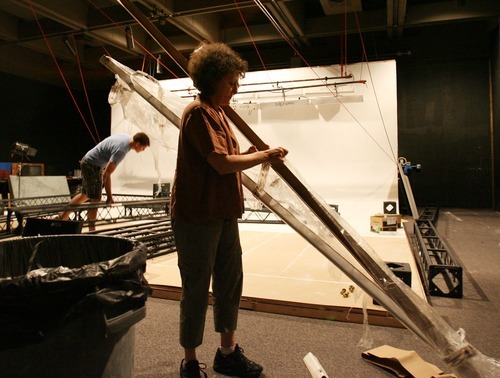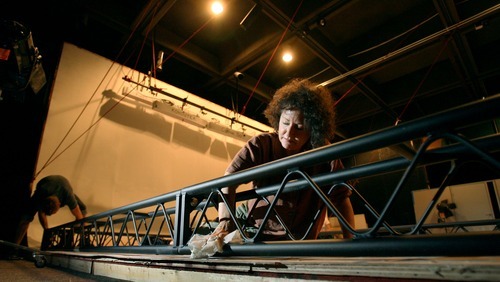This is an archived article that was published on sltrib.com in 2011, and information in the article may be outdated. It is provided only for personal research purposes and may not be reprinted.
The path of Utah dance professor Ellen Bromberg's career changed in an instant one day in the 1980s. That's when she became one of a few people outside the technical world to discover she could electronically "copy and paste" a sentence from one place to another in cyberspace. No scissors, glue or White-Out required.
"To me, this technology meant that the physical world was never going to be the same, that we could disrupt linear thought," said Bromberg, an associate professor of modern dance at the University of Utah. "There was an intuitive leap that the physical world was changing, and it felt to me like it was on a level of imagination."
Bromberg said she was more excited to get her first Macintosh than her first car, and that computer still occupies an honored place on her display case as a reminder of the imaginative leap it allowed her to take.
—
A technological leap at the U. • That leap led to a residency program combining research into arts and technology at Arizona State University's Institute for Studies in the Arts. The institute had an "intelligent stage" — a fully interactive stage programmed to trigger lights, sound and video by movement.
"Once the technology entered my awareness, I understood that as a choreographer, I was no longer restricted by time and space in the ways I was accustomed to," Bromberg said. "By liberating the physical body from this anchor, a whole new language of possibilities emerged. Causality, linearity and even gravity was called into question, through the body's representation in a digital world."
Bromberg has devoted the past decade to developing a dance media lab at the U., modeled on the technology at ASU. Ready for operation this fall, the lab is equipped with computers, a green screen, video projection, animation and motion-tracking software, sound and lights.
—
Dance for the Camera • This hybrid of technology and art coalesces with Bromberg's other artistic mission, the Graduate Screendance Certificate, which came to fruition last fall. Bromberg describes the program conceptually as a place where "dance, film, sound and digital media intersect in a complex discourse of ideas about the body on screen."
This week, Bromberg's dedication to the esoteric form manifests in the U.'s eighth International Dance for the Camera Workshop and Festival, the longest ongoing such festival in the nation. Expanded this year to a weeklong workshop, the festival will include a residency by award-winning Scottish dance filmmaker Katrina McPherson and weekend screenings.
McPherson is delighted for her first-ever U.S. residency due to the prospect of working with Bromberg, who is highly regarded internationally. Drawn also to the prospect of working with dancers and filmmakers, McPherson said, "The U.'s screendance program is one of only a few programs of its kind in the world."
Juried international student works will be shown at the Marriott Center for Dance on Thursday. On Friday at the U.'s Post Theater, McPherson will screen and discuss five of her short films. On Saturday, she will present the American premiere of her documentary about British dancer Kirstie Simson, "Force of Nature."
"By bringing together students from both dance and film, Ellen enables real collaboration of the art forms," McPherson said. "And through her regular festivals and screenings, [she] creates a valuable platform for international work, particularly by those early on in their careers."
—
The practicality of technology • Exploring technology and collaborating with other artists transformed the way Bromberg looked at performance — and at life.
"Collaboration requires cooperation and shared vision, so if we look at this multimedia performance lab as a training ground, it is a metaphor for nurturing people who can bridge across differences," Bromberg said. "These are skills that are profoundly necessary for creating citizens of the world."
Understanding technology is a matter of practicality in the contemporary world, according to Bromberg.
"I want students to have an opportunity to explore performance in the 21st century," she said. "An important aspect of 21st-century performance is a full integration of media, technology and the performing body. The Screendance Certificate is a way for students to become knowledgeable about all aspects of production. They have to know what they're doing in order to be equipped as artists of the future."
One thing students will learn is "motion capture," the technology often used in video games as well as this summer's blockbuster "Rise of the Planet of the Apes." Actor Andy Serkis has become famous for motion-capture roles, such as the chimpanzee Caesar in "Rise of the Planet of the Apes," Gollum in the "Lord of the Rings" trilogy and the lead character in the 2005 remake of "King Kong."
—
The artistic question • In the commercial world, according to Bromberg, such technology can be used to create entertainment products. But in the hands of an artist, it becomes part of the creative process.
"The commercial application is interesting from a technological achievement perspective, but for me the art-making process is one of inquiry," she said of the creative material as well as the artist's intentions.
Which brings us back to the camera where Bromberg began her technological journey 20 years ago. She considers the camera a metaphor that functions as a telescope and a microscope for viewing the human experience.
"It allows you to see things more closely and at a greater distance and from a different perspective," she said. "I love the live moment, but there is something about the frame, the moving frame, that I find very exciting. It can be a destabilizing thing. It brings into question gravity, time and space, and how we derive meaning from what we see — it all comes back to the idea of inquiry."
facebook.com/tribremix International Dance for the Camera screenings
This is the eighth annual dance film festival, featuring visiting dance filmmaker Katrina McPherson.
Event • Screenings of international student films, selected in a juried competition
When • Thursday, Sept. 15, 8 p.m.
Where • Marriott Center for Dance, 330 S. 1500 East, University of Utah campus, Salt Lake City
Info • $7.50, $5 students; free for U. students with ID
Event • Screenings of award-winning short films by McPherson, who will introduce her works
When • Friday, Sept. 16, 8 p.m.
Where • Fort Douglas Post Theater, 245 Fort Douglas Blvd., U. campus, Salt Lake City
Info • $7.50, $5 students; free for U. students with ID
Event • Master class with improvisational performer/teacher Kirstie Simson, featured as the subject of McPherson's new documentary "Force of Nature"
When • Saturday, Sept. 17, 11 a.m.
Where • Marriott Center for Dance, 330 S. 1500 East, U. campus, Salt Lake City
Info • $15; free for U. students
Event • American premiere screening of McPherson's "Force of Nature"; filmmaker and subject will be present.
When • Saturday, Sept. 17, 8 p.m.
Where • Marriott Center for Dance, 330 S. 1500 East, U. campus, Salt Lake City
Info • $7.50; $5 students; free for U. students with ID
Also • To learn more about the Graduate Screendance Certificate, visit bit.ly/qKifvk or contact Ellen Bromberg at 801-587-9807 or e.bromberg@utah.edu.







